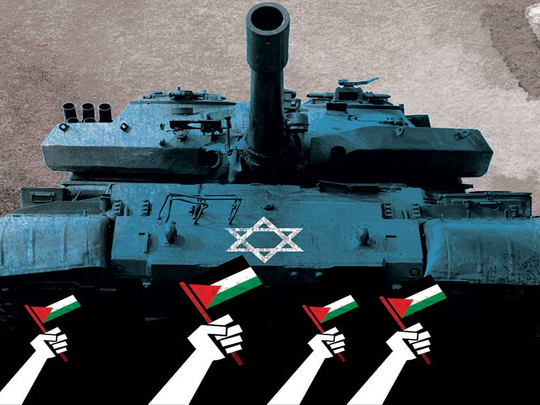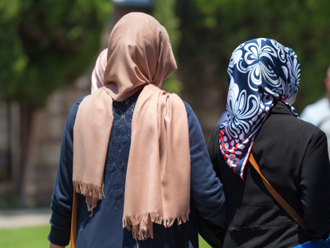
March 30, 2018 shall be etched in the collective Palestinian memory for generations to come. Not only was it a day on which Israelis massacred peaceful protesters, but it was also a day during which the Palestinian people stood their ground, united behind an ideal that transcends politics, geography and factionalism.
On that day commemorating The Great March, thousands of Palestinians walked into the deadly ‘buffer zone’ along the Gaza border — peacefully and knowingly within view of Israeli snipers. Their intention was clear: to be seen by the world as ordinary citizens who until now have been unseen and overlooked by politicians within Palestine and the world over.
They pitched tents, conversed, sang together and waved Palestinian flags — not the banners of the various factions. Families gathered, children played, even circus clowns provided entertainment. It was a rare moment of unity, and non-violent defiance.
The Israeli army’s response was, shall we say, ‘in character’. By shooting dead 15 unarmed protesters and wounding 773 people in a single day, using the latest technology in exploding bullets, they thought they could teach the Palestinians a lesson. It was prison guard handbook 101: beat them, beat them again. Kill them. Kill them again.
The numbers kept growing; the dead were counted in scores and the wounded in the thousands. Even journalists who merely attempted to capture that heroic but tragic moment to the world were shot, wounded or killed.
But why did Israeli soldiers kill or wound thousands of protesters who clearly posed no threat to them?
“Yesterday we saw 30,000 people,” tweeted the Israeli army on March 31. “We arrived prepared and with precise reinforcements. Nothing was carried out uncontrolled; everything was accurate and measured, and we know where every bullet landed.”
The tweet, which was captured by the Israeli rights group, B’Tselem, was soon deleted, a clear realisation that such a comment aimed at unarmed protesters could incite a huge outcry against Israel’s actions.
Palestinian popular mobilisation deeply concerns Israel, partly because it is a PR nightmare. By killing and wounding this number of Palestinians, Israel had hoped that the masses would retreat, and that the protests would subside and, eventually, end. This was not the case, of course.
But there is more to Israeli fear. The power of the Palestinian people, when united beyond factional allegiances, is immense. It disrupts Israel’s political and military tactics entirely, and places Tel Aviv wholly on the defensive. Since the cold-blooded murder of innocent people did not go unnoticed, it is important that we dig deeper into the social and political context that led tens of thousands of Palestinians to camp and rally at the border.
This current mobilisation is a reminder of previous historical events during which Palestinians rose in unison to challenge oppression and demand freedom.
Palestinian popular resistance is neither a new phenomenon, nor an alien one. General mass strikes and civil disobedience, challenging British imperialism and Zionist colonies in Palestine go back to nearly a century, culminating in the six-month-long general strike of 1936.
Since then, popular resistance has been a regular occurrence in Palestinian history, featured prominently during the First Intifada, the popular uprising of 1987.
It goes without saying that Palestinians need no lectures on how to resist the Israeli occupation, combat racism and defeat apartheid. They, and only they, are capable of developing the proper strategies and tools that will eventually lead them to freedom. The deteriorating political and humanitarian situation in Gaza makes that strategy more urgent than ever and there is a reason for that.
Gaza is being suffocated. Israel’s decade-long blockade, combined with Arab neglect and a prolonged feud between Palestinian factions, have all served to drive Palestinians to the brink of starvation and political despair. Something has to give.
The mass mobilisation of March 30 was not just about underscoring the Right of Return for Palestinian refugees (as enshrined in international law), nor about commemorating Land Day, an event that has united all Palestinians since the bloody protests of 1976. The protest was about reclaiming the Palestinian agenda, transcending political infighting and giving a voice back to the people.
Today, the Palestinian leadership is becoming increasingly irrelevant and isolated. The Palestinian National Authority (PNA) in Ramallah is rapidly losing its credibility among Palestinians, thanks to long-standing accusations of corruption, with calls for the PNA leader Mahmoud Abbas to resign (his mandate having technically expired in 2009). Last December, US President Donald Trump compounded the isolation of the PNA, recognising Jerusalem as the capital of Israel, in defiance of international law and UN consensus. Many see this act as the precursor designed to further marginalise the PNA.
Hamas — originally a grassroots movement born out of the refugee camps in Gaza during the First Intifada — is now equally weakened by political isolation.
Recently, there seemed to be a ray of hope. After several failed initiatives towards reconciliation with Fatah, a deal was signed between both rival parties in Cairo last October.
Alas, like previous attempts, it began to falter almost immediately. The first hurdle came on March 13 when the convoy of PNA Prime Minister, Rami Hamdallah, was the target of an apparent assassination attempt. Hamdallah was en route to Gaza through an Israeli border crossing. The PNA quickly blamed Hamas for the attack which the latter vehemently denied. Palestinian politics went back to square one.
But then, March 30 happened, and the criminal response of the Israeli army was predictable. Their aim was to discipline and deter the Palestinian people from pursuing the popular resistance strategy.
Condemnations of this massacre flooded in from respected figures and groups internationally, like Pope Francis and Human Rights Watch. This glimmer of attention may have provided Palestinians with an opportunity to elevate the injustice of the siege on the global political agenda, but is sadly, of little consolation to the families of the dead.
Aware of the international spotlight, Fatah immediately took credit for this spontaneous act of popular resistance. Deputy Chairman, Mahmoud Al Aloul, said that the protesters mobilised to support the PNA “in the face of pressure and conspiracies concocted against our cause”, undoubtedly referring to Trump’s strategy of isolation towards the Fatah-dominated PNA.
But this is not the reality. This is about the people finding expression outside the confines of factional interests; a new strategy. This time, the world must listen.
Ramzy Baroud is a journalist, author and editor of Palestine Chronicle. His latest book is The Last Earth: A Palestinian Story (Pluto Press, London, 2018). Baroud has a PhD in Palestine Studies from the University of Exeter and is a non-resident scholar at Orfalea Center for Global and International Studies, University of California Santa Barbara. His website is www.ramzybaroud.net.









